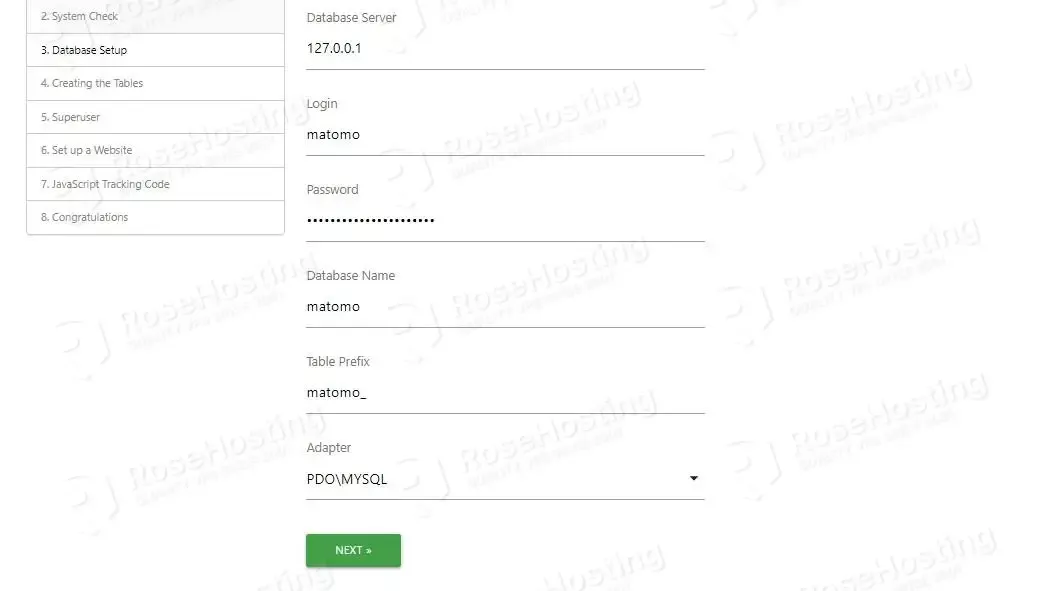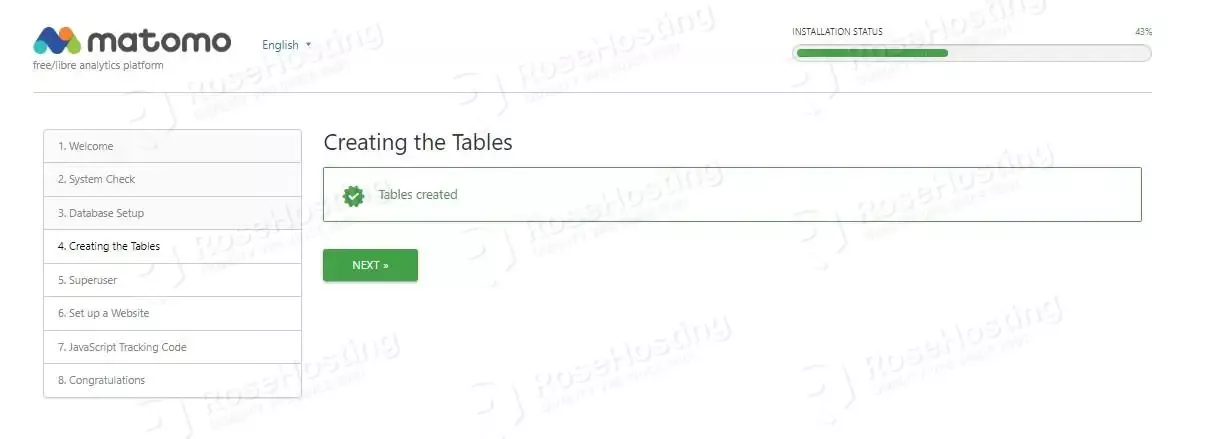In this blog post, we will show you how to install Matomo on Debian 11 OS.
Matomo is a free and open-source web analytics application used for live tracking of website visits. Matomo is written in PHP, and it uses MySQL for storing analytics data. It was known previously as Piwik and, in 2018, was officially renamed Matomo. In this tutorial, we will install Matomo with the LAMP stack.
Installing Matomo on Debian 11 with LAMP stack is very easy, and it may take up to 30 minutes. Let’s get things done!
Table of Contents
Prerequisites
- A server with Debian 11 as OS
- User privileges: root or non-root user with sudo privileges
Step 1. Update the System
Update the system packages to the latest versions available. Execute the following command:
sudo apt-get update -y && sudo apt-get upgrade -y
Step 2. Install LAMP Stack
We will start with installing the Apache Web server. To do that, execute the following command:
sudo apt-get install apache2 -y
Once installed, start and enable the service.
sudo systemctl enable apache2 && sudo systemctl start apache2
Check if the service is up and running:
sudo systemctl status apache2
You should receive the following output:
root@host:~# sudo systemctl status apache2
● apache2.service - The Apache HTTP Server
Loaded: loaded (/lib/systemd/system/apache2.service; enabled; vendor preset: enabled)
Active: active (running) since Thu 2023-02-02 10:56:26 CST; 1 day 4h ago
Docs: https://httpd.apache.org/docs/2.4/
Main PID: 442 (apache2)
Tasks: 9 (limit: 4675)
Memory: 27.8M
CPU: 6.175s
CGroup: /system.slice/apache2.service
Next, we will install the MariaDB database service. To install it execute the following command:
sudo apt-get install mariadb-server -y
Start and enable the mariadb.service with the following commands:
sudo systemctl start mariadb && sudo systemctl enable mariadb
Check the status of the mariadb.service
sudo systemctl status mariadb
You should receive the following output:
root@host:~# sudo systemctl status mariadb
● mariadb.service - MariaDB 10.5.18 database server
Loaded: loaded (/lib/systemd/system/mariadb.service; enabled; vendor preset: enabled)
Active: active (running) since Fri 2023-02-03 15:55:08 CST; 12s ago
Docs: man:mariadbd(8)
https://mariadb.com/kb/en/library/systemd/
Main PID: 5350 (mariadbd)
Status: "Taking your SQL requests now..."
Tasks: 20 (limit: 4675)
Memory: 70.3M
CPU: 724ms
CGroup: /system.slice/mariadb.service
└─5350 /usr/sbin/mariadbd
The last of the LAMP stack is the PHP, along with its extensions. First, add the GPG key and the repo with the following commands:
sudo apt -y install lsb-release apt-transport-https ca-certificates wget -O /etc/apt/trusted.gpg.d/php.gpg https://packages.sury.org/php/apt.gpg echo "deb https://packages.sury.org/php/ $(lsb_release -sc) main" | tee /etc/apt/sources.list.d/php.list sudo apt-get update -y
Once the PHP key and repo are added, you can install the PHP with extensions using this long command:
sudo apt-get install php8.1 php8.1-common php8.1-curl libapache2-mod-php php8.1-imap php8.1-redis php8.1-cli php8.1-snmp php8.1-xml php8.1-zip php8.1-mbstring php8.1-mysql php-mbstring -y
After successful installation, you can check the PHP version with the following command:
php -v
You should get the following output:
root@host:~# php -v
Created directory: /var/lib/snmp/cert_indexes
PHP 8.2.2 (cli) (built: Feb 3 2023 15:21:45) (NTS)
Copyright (c) The PHP Group
Zend Engine v4.2.2, Copyright (c) Zend Technologies
with Zend OPcache v8.2.2, Copyright (c), by Zend Technologies
We are ready to proceed with database creation and Matomo installation when the LAMP stack is installed.
Step 3. Create a Matomo database and user
To create a Matomo database, the Matomo user logs in to the MySQL command line with the mysql command and executes the following lines of code one by one:
CREATE USER 'matomo'@'localhost' IDENTIFIED BY 'YourStrongPasswordHere'; CREATE DATABASE matomo; GRANT ALL PRIVILEGES ON matomo.* TO 'matomo'@'localhost'; FLUSH PRIVILEGES; EXIT;
Step 4. Install Matomo
Go into the Apache document root directory and download the Matomo installation:
cd /var/www/html/ wget https://builds.matomo.org/matomo-latest.zip
Extract the file and remove the zip folder:
unzip matomo-latest.zip rm matomo-latest.zip
Set the right permission to matomo directory and files:
cd /var/www/html
sudo chown -R www-data:www-data matomo/
find . -type d -exec chmod 755 {} \;
find . -type f -exec chmod 644 {} \;
h2>Step 5. Create Apache Virtual Host File
Go into the Apache directory and create a configuration file for the Matomo.
cd /etc/apache2/sites-available/ touch matomo.conf
Open the file, paste the following lines of code, save the file and close it.
<VirtualHost *:80>
ServerName yourdomain.com
DocumentRoot /var/www/html/matomo
<Directory /var/www/html/matomo>
AllowOverride All
</Directory>
ErrorLog ${APACHE_LOG_DIR}/error.log
CustomLog ${APACHE_LOG_DIR}/access.log combined
</VirtualHost>
Enable the Apache configuration for Matomo and rewrite the module.
a2dissite 000-default.conf sudo a2enmod rewrite sudo a2ensite matomo.conf
Check the syntax:
apachectl -t
You should receive the following output:
root@vps:~# apachectl -t Syntax OK
If the syntax is OK, restart the Apache service.
systemctl restart apache2
Step 6. Finish Matomo Installation
Access the URL at http://yourdomain.com. You should see the following screen:
Click on the Next button. On the next window, if everything is OK, the system check will pass. Click on the Next button as well:
Fill in the Database name, database user, and password you set in step 3.
The tables will be created.
In the next window, create the administrator user and set a strong password:
Next, set the website name and your URL.
On the next window, Matomo will generate the tracking code that you will need to insert into the code of your website.
That’s it; you successfully installed Matomo. Click on the Continue to Matomo button, and you should see the login form.
If you find some difficulties installing the Matomo on Debian 11, you can contact our system admins, who will help you with their expertise. All you need to do is to contact our support via ticket or live chat. We are available 24/7.
PS. If you liked this post on how to install Matomo on Debian 11, please share it with your friends on social networks or simply leave a reply below. Thanks.








Great tutorial.
I encountered a problem on my machine on the system check page of matomo: “matomo requires either the mysqli extension or both the PDO and pdo_mysql extensions.”
I was able to resolve this by running this command:
apt-get install php-mysql